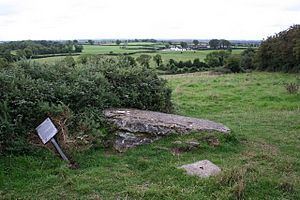Clonfinlough Stone facts for kids
Quick facts for kids Clonfinlough Stone |
|
|---|---|
| Native name Irish: Cloch Chluain Fionnlocha |
|
 |
|
| Type | Rock art |
| Location | Clonfinlough, Clonmacnoise, County Offaly, Ireland |
| Built | Bronze Age |
| Official name: Clonfinlough Rock Art | |
| Reference no. | 336 |
| Lua error in Module:Location_map at line 420: attempt to index field 'wikibase' (a nil value). | |
The Clonfinlough Stone is a special rock with ancient carvings. It's a protected National Monument in County Offaly, Ireland. This stone is a great example of rock art from long ago.
Contents
Where to Find the Clonfinlough Stone
The carved stone at Clonfinlough is located on a hill called Esker Hill. It's about 4 kilometers (2.5 miles) east of Clonmacnoise. You can find it near the River Shannon and a bog called Mongan Bog.
History of the Stone's Carvings
Ancient Bronze Age Art
Scientists think the carvings on the stone are very old. They believe they were made during the Bronze Age. This time period was from about 2500 BC to 500 BC. People lived in a village nearby during that time. They had round houses surrounded by a strong wooden fence called a palisade.
Pilgrims and Later Carvings
But there's another idea about some of the carvings! Some marks look like ones found in Galicia, Spain. A famous old walking path, the Camino de Santiago, went through Clonmacnoise. So, some people think Christian pilgrims might have added carvings. This could have happened in the 13th or 14th century. The Clonfinlough Stone might have been a stopping point for these travelers.
What the Stone Looks Like
The Clonfinlough Stone is a huge rock that was moved by a glacier. It's made of Carboniferous Limestone. The stone lies flat on the ground. It measures about 3 meters (10 feet) long and 2.45 meters (8 feet) wide. It's about 0.75 meters (2.5 feet) thick and weighs around 14 tonnes.
Marks and Symbols
The stone has many interesting marks carved into it. These include crosses and round "cup-marks." There's also a "split-year sign," which is a circle divided in two. You can also see the letters "DOD" and three impressions that look like feet.
Images for kids


